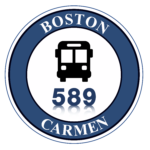WBUR 90.9 FM: Attacks On MBTA Bus Drivers Are On The Rise
June 10, 2013
WBUR 90.9 FM | By Bruce Gellerman | June 10, 2013
BOSTON — The number of attacks on MBTA bus drivers has been soaring this year. So far there have been 50 attacks compared to 33 this time last year.
MBTA offficials aren’t sure what’s causing the increase in violent attacks on bus drivers but are hoping more technology, new legislation and increased public awareness will help.
There are more than 180 MBTA bus routes in eastern Massachusetts, with 1,100 buses driven by some 6,000 drivers, carrying 400,000 people a day.
Transit Police Effort
Joseph O′Connor, Superintendent-in-Chief of the MBTA Transit Police. (Bruce Gellerman/WBUR)
John O’Connor, Superintendent-in-Chief of the MBTA Transit Police, leads the battle against assaults on MBTA drivers.
“It’s very dangerous. These operators are operating heavy vehicles with passengers on public ways, and any assault on an operator really puts the public as a whole at risk,” O’Connor explained. “We put our officers where the problems are — it’s the whole cops-on-dots philosophy of where we should put police officers.”
But increasingly there are more dots than cops. O’Connor believes growing frustration with fare hikes and service cuts plays a role.
“This is where we see quite often where the assaults come from, where an operator is trying to collect the fare from someone and, for whatever reason, the person will assault the bus operator — and in quite a few instances we see they’re spitting on the operator,” O’Connor said.
With just 271 transit police officers, the MBTA is increasingly turning to science to stop the violence.
“We also instituted a program where we collect DNA now,” O’Connor said. “We’ll submit that DNA to a state lab for analysis to see if at some point we can make contact between the suspect and the assault and solve those cases.”
Types Of Assaults
“Don’t touch the driver. Violence toward a bus driver is against the law. We will prosecute,” reads the MBTA seat decal in this mock-up designed to show what it would look like if a person were seated in front. (MBTA)
A rider was sentenced last week to three months in prison for choking a driver. But, for some reason, spitting is the most frequent assault, accounting for 40 percent of the attacks on MBTA bus drivers.
“It’s probably the most degrading thing that you can have happen to you as a human being,” said John Lee, who drove an MBTA bus for 13 years and who now serves as president of the Carmen’s Union, Local 589, which represents MBTA operators.
“I would rather myself be hit than spit on. It’s something that should never be tolerated,” he said.
Lee detailed a variety of assaults.
“We have people — they cut you, they bite you. We’ve had people take urine in cups and throw them at drivers. And bodily fluids is a real concern,” he said. “I have a member who was assaulted. And it was learned that the female had Hepatitis C. So now my member, who’s a single mom, had to be tested for Hepatitis C, not knowing if she’s contracted this disease through just simply coming to work and doing her job. It has to stop.”
The Loophole
Under current Massachusetts law, unless a transit officer actually sees the attack in progress, there’s little police can do except issue a summons and hope the suspect shows up in court.
That’s a problem, said Lee.
“This is the scenario: I can have a 5-foot-nothing, 100-pound female driving a bus, have a 6-foot-4 male, 250 pounds, smash her across her face, blood, visual evidence of an assault. Witnesses on the bus, when the police arrive, point to the individual that did it, and they cannot arrest him,” he said. “That’s reality.”
Proposed Legislation
State representative Jim Miceli of Tewskbury has introduced legislation that would allow transit police to arrest a suspect based on statements from the riders and driver — even if the officer did not actually witness the assault.
“I just felt they should be protected,” he said.
Screenshot of the MBTA’s See Say app.
Miceli’s proposal came after a particularly vicious attack in March when a mob of a dozen or more young people beat up a bus driver in Dorchester at 1 a.m. So far, only two suspects have been arrested.
“You’ve got people whose lives are in jeopardy, so to me it was a no-brainer,” Miceli said.
Public Awareness Campaign
Recently the MBTA began broadcasting public service announcements on the radio. And, as part of a public awareness campaign, there are new signs on the backs of some bus seats, which make it look like the rider in front is handcuffed.
The MBTA has also introduced their See Say App for smartphones. Superintendent-in-Chief O’Connor said riders can use it, if they they see an attack, to send text messages to dispatchers.
“One of the unique features of that is they can also snap a picture of offenders or people that are creating problems and, in that app, it shuts off the flash so they can do that anonymously,” O’Connor explained.
Prevention And Surveillance
The MBTA will soon begin a pilot program installing barriers on some buses to protect drivers, but most buses already have an emergency switch that operators can hit if they’re attacked. It sets off flashing green lights outside of their vehicles.
Some buses — a third of the MBTA’s fleet — also have video cameras. The footage of assaults is posted on the websites of the MBTA and the Carmen’s Union. More buses will get cameras when money for the financially strapped transit service becomes available.
Lee is all for cameras but said they can give drivers a false sense of security.
“Videos are not here to prevent anything. Any kind of attack, any kind of vandalism, any kind of anything. All’s a video does is record it so that they know who did, they know how it was done,” Lee said. “I can only liken it to our terrorist attack on Marathon Monday — there were cameras everywhere. It didn’t stop it from occurring, but the use of those cameras allowed our agencies to go after of those who did it and find them.”
Civil Liberties At Stake?
But post-Boston Marathon bombing, there are growing concerns about overreacting and relying too much on surveillance technology.
Kade Crockford, of the ACLU of Massachusetts, gestures toward a MBTA surveillance camera. (Bruce Gellerman/WBUR)
“It’s not simply ‘Do we want more cameras on the buses today?’” said Kade Crockford, director of the Technology for Liberty Project at the ACLU of Massachusetts. “It’s ‘Do we want more cameras on the buses today and do we want them to be networked and do we want them to have incredibly powerful technologies built into the back end that enable the government to identify everybody who walks onto the bus simply using their face?’ There’s a reason that we don’t tattoo our social security numbers on our foreheads, right? But face recognition obliterates that distinction.”
So far, that technology is not being used on the MBTA, but Crockford said that in order to ensure the safety of drivers, riders and civil liberties, there has to be a serious public discussion. And that’s something that the president of the union and the superintendent of the transit police agree has to happen.






Recent Comments